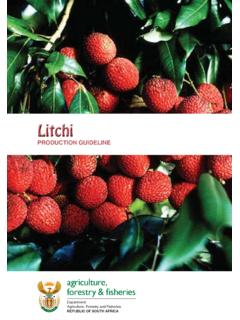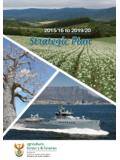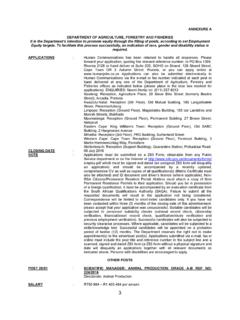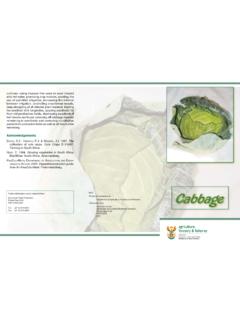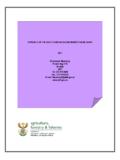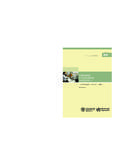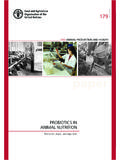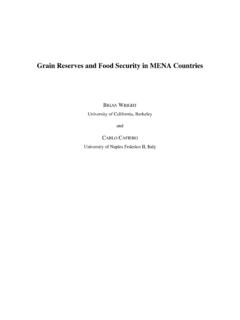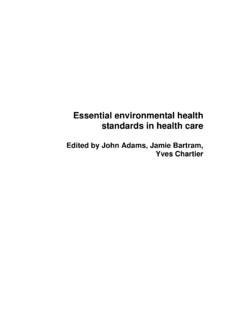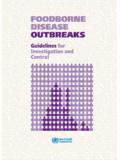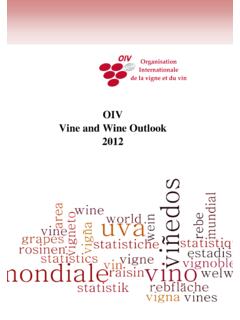Transcription of sugar cane prod guideline - Department of …
1 PRODUCTION guideline . Sugarcane agriculture , forestry & fisheries Department : agriculture , Forestry and Fisheries REPUBLIC OF SOUTH AFRICA. PRODUCTION guideline . Sugarcane 2014. Department of agriculture , Forestry and Fisheries 2014. Printed and published by Department of agriculture , Forestry and Fisheries Design and layout by Directorate Communication Services Obtainable from Resource Centre Directorate Knowledge and Information Management Private Bag X388. PRETORIA. 0001. CONTENT. General aspects .. 1. Cultivation practices .. 7. Post-harvest handling.
2 21. Production schedule .. 23. Utilisation .. 24. References .. 24. iii GENERAL ASPECTS. Classification Scientific name: Saccharum officinarum Common names: Sugarcane (English), suikerriet (afrikaans), umoba (Isi- zulu/siSwati), moba (Sepedi), mofha (Venda), Letlhaka la sokore (Setswana/. Sesotho). Sugarcane is any of several species of tall perennial true grasses of the genus Saccharum, tribe Andropogoneae and it belongs to the grass family called Poaceae. The official classification of sugarcane is Saccharum officinarum. It is common in tropical and subtropical countries throughout the world.
3 Several different horticultural varieties are known, and they differ by their stem color and length. Sugarcane is composed of six species of perennial grasses of the genus Saccharum L., in tribe Andropogoneae of the Poaceae. There are two wild species (S. spontaneum L. and S. robustum) and 4 cultivated species, S. officinarum L., S. barberi, S. sinense and S. edule. The 4 cultivated species are complicated hybrids, and all intercross readily. All commercial canes grown today are inter-specific hybrids. Origin and distribution Sugarcane is indigenous to tropical South and Southeast Asia.
4 Different species likely originated in different locations, with S. spontaneum occuring in the wild from eastern and northern Africa, through the Middle East, to India, China, Taiwan, and Malaysia, and through the Pacific to New Guinea. The center of origin is probably in northern India which forms the smallest chromosome numbers. S. robustum is found along river banks in New Guinea and some of its adjacent islands and is indigenous to the area. S. officinarum (or noble cane ) most likely originated in New Guinea. It is only suited for tropical regions with favourable climate and soil.
5 S. barberi probably originated in India. S. sinense occurs in portions of India, Indo- China, southern China and Taiwan. S. edule is thought to be a sterile form of S. robustum and is found only in New Guinea and nearby islands. Sugarcane has been cultivated since ancient times and it was one of the first cash crops of early colonial America. It grew plentifully in the southern states, and was a major source of income for many plantations. It is grown 1. readily in the United States in Hawaii, Louisiana, Florida and Puerto Rico. The countries that produce the largest amounts of sugarcane are Brazil, India, China, Mexico, Thailand and Pakistan.
6 cane sugar is currently grown primarily in tropical regions. The highest latitudes at which cane is grown is in South Africa (KwaZulu-Natal), Argentina and at the southern extremes of the Australian industry at approximately 30 S, 34 N in northwest Pakistan, and 37 N in southern Spain. The first New World sugar cane mill began grinding in about 1516 in the Dominican Republic. sugar production spread to Cuba, Jamaica, Puerto Rico, and the other Greater Antilles by the end of the 1500's. Production levels South Africa The South African sugar industry is consistently ranking in the top 15 out of approximately 120 sugar producing countries worldwide.
7 There are approximately 26,400 registered sugarcane growers in South Africa, covering the provinces of KwaZulu-Natal, Mpumalanga and the Eastern Cape. Of the 26,000 sugarcane growers, more than 25,000 are small-scale growers producing about ten percent of the total crop. Large-scale growers (approximately 1,400) produce approximately 83% of the total sugarcane crop, while milling companies, with their own sugar estates, produce approximately seven percent of the crop. The bulk of the sugar belt receives sufficient rainfall to grow cane without irrigation; however, parts of northern KwaZulu-Natal and Mpumalanga regions produces cane under irrigation (approximately 30 percent of total production).
8 cane growers are represented by the South African cane Growers Association. There are 14 sugar mills in South Africa. Four mills are each owned by Illovo sugar Ltd and Tongaat Hulett sugar Ltd. Three mills are owned by Tsb sugar RSA Ltd, while Umfolozi sugar Mill (Pty). Ltd, UCL Company Ltd and Gledhow sugar Company (Pty) Ltd each own one mill. Only two mills are located in the Mpumalanga province, while the remainder is located in the KwaZulu- 2. Natal province. The sugar millers are represented by the South African sugar Millers' Association Limited.
9 Four of the mills are known as white end'' mills and produce their own refined sugar . For the 2013/14 season, sugar production is estimated at million tons, almost eight percent more than the million tons produced in the 2012/13, on a higher sugar cane crop. In the 2011/12 season, South Africa produced its lowest sugar crop in the past 15 years at million tons, due to a drought- affected production season. Sugarcane is produced each season from 14. mill supply areas, extending from Northern Pondoland in the Eastern Cape to the Mpumalanga Lowveld.
10 Of the 430 000 ha currently under sugar cane , about 68% is grown within 30 km of the coast and 17% in the high rainfall areas of KwaZulu-Natal. The balance is grown in the northern irrigated areas that comprise Pongola and the Mpumalanga Lowveld. South Africa continues to be one of the world's most cost-competitive producers of high quality sugar . It is a diverse industry combining the agricultural activities of sugarcane cultivation with the industrial factory production of raw and refined sugar , syrups and specialised sugars, and a range of by-products.




